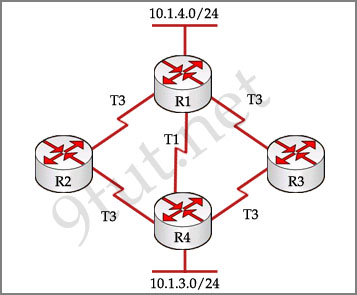CCNA – Operations 3
Here you will find answers to Operations Questions – Part 3
Question 1:
Your company wants to reconfigure a Catalyst 2950. which actions must be taken to erase the old configuration? (Choose three)
A – Erase flash
B – Restart the switch
C – Delete the VLAN database
D – Erase the startup configuration
Answer: B C D
Question 2:
If the subnet mask is 255.255.255.224, which of the following addresses can be assigned to network hosts? (Choose three)
A – 15.234.118.63
B – 92.11.178.93
C – 134.178.18.56
D – 192.168.16.87
Answer: B C D
Explanation:
The addresses can be assigned to network hosts are the addresses that satisfy these conditions:
+ They don’t belong to network addresses
+ They don’t belong to broadcast addresses
The last octet of the subnet mask is 224, which is 1110 0000 in binary form, so the increment is 32. This is the value we need to find out the network addresses and broadcast addresses when using the 255.255.255.224 subnet mask.
Network addresses: x.x.x.0, x.x.x.32,x.x.x.64,x.x.x.96,x.x.x.128,x.x.x.160,x.x.x.192,x.x.x.224
Broadcast addresses: x.x.x.31, x.x.x.63, x.x.x.95, x.x.x.127, x.x.x.159, x.x.x.191, x.x.x.223
(Notice we don’t care about the first three octets because the first three octets of the subnet mask are all 255)
From that we learn 15.234.118.63 is one of the broadcast addresses. Other answers are correct because they are neither network addresses nor broadcast addresses.
Question 3:
An administrator issues the command “ping 127.0.0.1” from the command line prompt on a PC host named PC1. If an ICMP reply is received, what does this confirm?
A – The PC host PC1 has connectivity with a local host
B – The PC host PC1 has connectivity with a Layer 3 device
C – The PC host PC1 has a default gateway correctly configured
D – The PC host PC1 has connectivity up to Layer 5 of the OSI model
E – The PC host PC1 has the TCP/IP protocol stack correctly installed
Answer: E
Explanation:
If you are having problems with your network then issue the command “ping 127.0.0.1” to prove the network card and the TCP/IP software is working correctly. Address 127.0.0.1 is reserved for the test loop back purpose.
Question 4:
Study the exhibit carefully, can you tell which three description are correct about the ways used by the router R1 to choose a path to the 10.1.3.0/24 network when different routing protocols are deployed? (Choose three)

A – When RIPv2 is the routing protocol, only the path R1-R4 is to be installed into the routing table by default
B – When RIPv2 is the routing protocol, the equal cost paths R1-R3-R4 and R1-R2-R4 are to be installed in the routing table
C – If both EIGRP and OSPF are working on the network with their default configurations, the EIGRP paths will be installed in the routing table
D – By default, if EIGRP is the routing protocol, the equal cost paths R1-R3-R4 and R1-R2-R4 will be installed in the routing table
Answer: A C D
Explanation:
RIP is a distance vector routing protocol and it uses hop count as the metric for path selection so only the path R1-R4 (with only 2 hops) will be installed into the routing table.
If both EIGRP and OSPF are used, the EIGRP paths will be installed in the routing table because the default administrative distance of EIGRP is 90 while that of OSPF is 110. Therefore these routers will choose EIGRP because it has lower administrative distance value (Notice that a lower value for the administrative distance indicates the more reliable route).
Question 5:
Which two statements describe characteristics of IPv6 unicast addressing? (Choose two)
A. Global addresses start with 2000::/3
B. Link-local addresses start with FE00:/12
C. Link-local addresses start with FF00::/10
D. There is only one loopback address and it is ::1
E. If a global address is assigned to an interface, then that is the only allowable address for the interface.
Answer: A D
Explanation:
Below is the list of common kinds of IPv6 addresses:
| Loopback address | ::1 |
| Link-local address | FE80::/10 |
| Site-local address | FEC0::/10 |
| Global address | 2000::/3 |
| Multicast address | FF00::/8 |
From the above table, we learn that A and D are correct while B and C are incorrect. Notice that the IPv6 unicast loopback address is equivalent to the IPv4 loopback address, 127.0.0.1. The IPv6 loopback address is 0:0:0:0:0:0:0:1, or ::1.
E is not correct because of anycast addresses which are indistinguishable from normal unicast addresses. You can think of anycast addresses like this: “send it to nearest one which have this address”. An anycast address can be assigned to many interfaces and the first interface receives the packet destined for this anycast address will proceed the packet. A benefit of anycast addressing is the capability to share load to multiple hosts. An example of this benefit is if you are a Television provider with multiple servers and you want your users to use the nearest server to them then you can use anycast addressing for your servers. When the user initiates a connection to the anycast address, the packet will be routed to the nearest server (the user does not have to specify which server they want to use).


